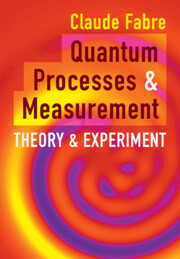Book contents
- Frontmatter
- Contents
- Introduction
- 1 Experiment: Detecting Single Quantum Objects
- 2 Description of Quantum Systems in Terms of the Density Matrix
- 3 Experiment: Quantum Processes
- 4 Evolution
- 5 Measurement
- 6 Experiment: Bipartite Systems
- 7 Entanglement
- 8 Experiment: Continuous Quantum Fluctuations
- 9 Continuous Variable Systems
- 10 Experiment: Parameter Estimation
- 11 Theory: Parameter Estimation
- A Basic Postulates of QuantumMechanics: a Reminder
- B Generalized Postulates of Quantum Mechanics
- C Description of Composite Systems
- D Qubits
- E Quantum Particle
- F Quantum Electromagnetic Field
- G Interaction between Light and Atoms
- H Interaction between Light Beams and Linear OpticalMedia
- I Interaction between Light Beams and Nonlinear OpticalMedia
- J Optomechanics
- K Basics of Circuit Quantum Electrodynamics
- References
- Index
K - Basics of Circuit Quantum Electrodynamics
Published online by Cambridge University Press: 27 July 2023
- Frontmatter
- Contents
- Introduction
- 1 Experiment: Detecting Single Quantum Objects
- 2 Description of Quantum Systems in Terms of the Density Matrix
- 3 Experiment: Quantum Processes
- 4 Evolution
- 5 Measurement
- 6 Experiment: Bipartite Systems
- 7 Entanglement
- 8 Experiment: Continuous Quantum Fluctuations
- 9 Continuous Variable Systems
- 10 Experiment: Parameter Estimation
- 11 Theory: Parameter Estimation
- A Basic Postulates of QuantumMechanics: a Reminder
- B Generalized Postulates of Quantum Mechanics
- C Description of Composite Systems
- D Qubits
- E Quantum Particle
- F Quantum Electromagnetic Field
- G Interaction between Light and Atoms
- H Interaction between Light Beams and Linear OpticalMedia
- I Interaction between Light Beams and Nonlinear OpticalMedia
- J Optomechanics
- K Basics of Circuit Quantum Electrodynamics
- References
- Index
Summary
Appendix K: this appendix is an introduction to another very active and promising domain of quantum physics, named circuit quantum electrodynamics (cQED), dealing with the quantum properties of macroscopic objects consisting of superconducting electrical circuits. In an LC circuit the energy is quantized, and charge and flux are two quantum canonical conjugate quantities that do not commute. Their quantum fluctuations are bound by a Heisenberg inequality. A Josephson junction inserted in the circuit introduces strong nonlinearities in the system, which breaks the equidistance between the energy levels and makes the circuit look like a qubit, called a transmon. Cooling at mK temperatures is necessary to have quantum effects dominate over thermal effects. The circuit is embedded in a resonant cavity, and the system bears many analogies with cavity QED and Jaynes–Cummings formalism for coupled photons and atoms. One can perform nondestructive read-out and control of the transmon, as well as phase-sensitive, quantum-limited amplification, with nonlinearities that are much stronger than the ones used in quantum optics.
Keywords
- Type
- Chapter
- Information
- Quantum Processes and MeasurementTheory and Experiment, pp. 279 - 288Publisher: Cambridge University PressPrint publication year: 2023

